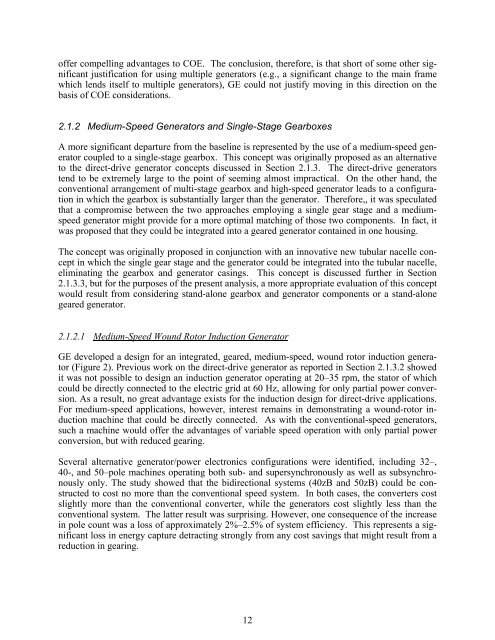Advanced Wind Turbine Program Next Generation Turbine ... - NREL
Advanced Wind Turbine Program Next Generation Turbine ... - NREL
Advanced Wind Turbine Program Next Generation Turbine ... - NREL
You also want an ePaper? Increase the reach of your titles
YUMPU automatically turns print PDFs into web optimized ePapers that Google loves.
offer compelling advantages to COE. The conclusion, therefore, is that short of some other significant<br />
justification for using multiple generators (e.g., a significant change to the main frame<br />
which lends itself to multiple generators), GE could not justify moving in this direction on the<br />
basis of COE considerations.<br />
2.1.2 Medium-Speed Generators and Single-Stage Gearboxes<br />
A more significant departure from the baseline is represented by the use of a medium-speed generator<br />
coupled to a single-stage gearbox. This concept was originally proposed as an alternative<br />
to the direct-drive generator concepts discussed in Section 2.1.3. The direct-drive generators<br />
tend to be extremely large to the point of seeming almost impractical. On the other hand, the<br />
conventional arrangement of multi-stage gearbox and high-speed generator leads to a configuration<br />
in which the gearbox is substantially larger than the generator. Therefore,, it was speculated<br />
that a compromise between the two approaches employing a single gear stage and a mediumspeed<br />
generator might provide for a more optimal matching of those two components. In fact, it<br />
was proposed that they could be integrated into a geared generator contained in one housing.<br />
The concept was originally proposed in conjunction with an innovative new tubular nacelle concept<br />
in which the single gear stage and the generator could be integrated into the tubular nacelle,<br />
eliminating the gearbox and generator casings. This concept is discussed further in Section<br />
2.1.3.3, but for the purposes of the present analysis, a more appropriate evaluation of this concept<br />
would result from considering stand-alone gearbox and generator components or a stand-alone<br />
geared generator.<br />
2.1.2.1 Medium-Speed Wound Rotor Induction Generator<br />
GE developed a design for an integrated, geared, medium-speed, wound rotor induction generator<br />
(Figure 2). Previous work on the direct-drive generator as reported in Section 2.1.3.2 showed<br />
it was not possible to design an induction generator operating at 20–35 rpm, the stator of which<br />
could be directly connected to the electric grid at 60 Hz, allowing for only partial power conversion.<br />
As a result, no great advantage exists for the induction design for direct-drive applications.<br />
For medium-speed applications, however, interest remains in demonstrating a wound-rotor induction<br />
machine that could be directly connected. As with the conventional-speed generators,<br />
such a machine would offer the advantages of variable speed operation with only partial power<br />
conversion, but with reduced gearing.<br />
Several alternative generator/power electronics configurations were identified, including 32–,<br />
40-, and 50–pole machines operating both sub- and supersynchronously as well as subsynchronously<br />
only. The study showed that the bidirectional systems (40zB and 50zB) could be constructed<br />
to cost no more than the conventional speed system. In both cases, the converters cost<br />
slightly more than the conventional converter, while the generators cost slightly less than the<br />
conventional system. The latter result was surprising. However, one consequence of the increase<br />
in pole count was a loss of approximately 2%–2.5% of system efficiency. This represents a significant<br />
loss in energy capture detracting strongly from any cost savings that might result from a<br />
reduction in gearing.<br />
12
















